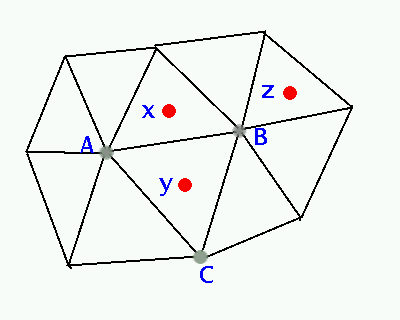for (p0=pfirst..plast)
for (p1=pfirst..plast)
Interaction(p0<->p1)
(a) Deterministic explicit interaction
for (p=pfirst..plast)
{ g=GridNode(p);
if (R<InteractionProbability(p,g))
Borrow(g>-p);
}
for (p=pfirst..plast)
{ g=GridNode(p);
if (R<PayBackProbability(p,g))
PayBack(g->p)
}
(b) Probabilistic implicit interaction
Figure1 present the comparison between the
conventional and the proposed interaction schemes. Here
,0,1 designate particles looping over the complete
particle set, is the neighboring grid node and is a
random number generated from the appropriate probability
distribution. The grid-node selection with function GridNode
does not involve any looping over the nodes, since the particle
carries the information on the current cell it is in and its
vertexes (grid-nodes). The essential feature of the new scheme
is the mechanism by which a grid-node can "borrow" and then
return back various properties of the particle. Since the
borrowed quantities may be of either negative or positive sign,
the term "borrow" would actually mean either "borrow" or "lend",
depending on the sign. In contrast to the common deterministic
interaction algorithm which is realized as two nested loops over
the particles (Fig.1a), and which we call an
explicit interaction scheme, the described procedure, which we
call a probabilistic implicit interaction scheme, is
realized in two sequential loops (Fig.1b), corresponding
to the two stages of virtual interaction with the grid.
Accordingly, the execution time of the algorithm is linear in
the particle number, whereas the algorithms based on direct
particle-particle interaction are worse than linear - usually
quadratic (Fig.1a), or maybe slightly better when space
subdivision is introduced to keep the particle-particle
connectivity information local
The technique is realized on a vertex-centered triangular grid with overlapping control volumes, which is also used for the solution of Navier-Stokes equation with a control-volume method [{Ferziger and Peric, }{1997}]. This choice of grid precludes the blockage of interactions between the particles located on different sides of a grid-cell face, like particles (x,y) in Fig.2. In this example the grid node A in the figure is engaged in virtual interaction with particles (x,y), node B with particles (x,y,z) and node C with particle y. Consequently, interaction between the particles (x,y) can occur via nodes A and B, whereas the interaction between the particles (x,y) and (y,z) can only occur via node B.

In the scheme above the interaction range that can be handled by the method will be limited by the size of a local control-volume. However, it would be possible to eliminate this grid-sensitivity by introducing an appropriate mechanism of virtual interaction between the grid nodes themselves. This may involve formulating a diffusion-like process, by which virtual quantities stored at each grid-node would be transported to the neighboring grid-nodes and so on. In this way the exchange of quantities between the particles will not be limited by the local control-volume sizes.